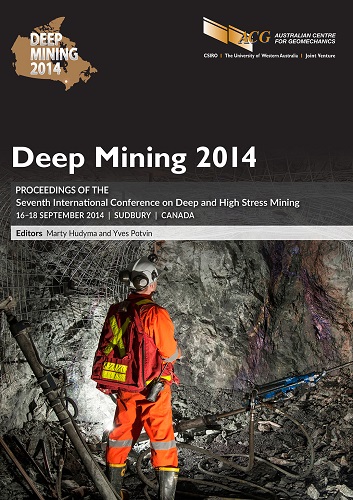Ultra rapid strength development in dry-mix shotcrete for ultra rapid support in challenging mining conditions

|
Authors: Lemay, J-D; Jolin, M; Gagné, R |
DOI https://doi.org/10.36487/ACG_rep/1410_17_Lemay
Cite As:
Lemay, J-D, Jolin, M & Gagné, R 2014, 'Ultra rapid strength development in dry-mix shotcrete for ultra rapid support in challenging mining conditions', in M Hudyma & Y Potvin (eds), Deep Mining 2014: Proceedings of the Seventh International Conference on Deep and High Stress Mining, Australian Centre for Geomechanics, Perth, pp. 271-279, https://doi.org/10.36487/ACG_rep/1410_17_Lemay
Abstract:
Recent development in the field of cementing materials has brought forward many non-traditional binder systems. Engineers involved in the fields of emergency repairs and rapid ground support have been on the lookout for materials that allow rapid production, placement and, most of all, very rapid strength development kinetics. One binder system that fits the description is composed of ordinary Portland cement (OPC), calcium aluminate cement (CAC) and calcium sulfate (C$). However, this type of binder also sometimes exhibits difficult workability that severely limits its use in regular cast in-place concrete. This limitation is overcome when using dry-mix shotcrete as a placement method, since the contact between water and cement occurs in the nozzle immediately before placement, workability problem are avoided. As a part of a graduate project at Laval University, 49 different mixes, including simple, binary and (mainly) ternary blends, were tested. Two majors parameters were studied, the development of compressive strength and the volumetric stability. The numerous binder compositions tested allowed the selection of a stable optimised formulation in regard of early compressive strength and volumetric stability. Finally, the selected formulation was successfully tested with industrial dry-mix shotcrete equipment to verify the large scale placement feasibility of such a product.
References:
American Concrete Institute 2005, ACI-506.R: Guide to Shotcrete, ACI, Farmington Hills.
American Concrete Institute 2009, CP-60(09): Craftsman Workbook for ACI Certification of Shotcrete Nozzleman, ACI, Farmington Hills.
ASTM International 2003, C1140: Standard Practice for Preparing and Testing Specimens from Shotcrete Test Panels, ASTM International, West Conshohocken.
ASTM International 2005, C1604: Standard Test Method for Obtaining and Testing Drilled Cores of Shotcrete, ASTM International, West Conshohocken.
Heere, R, Morgan, DR 2002, ‘Determination of Early-Age Compressive Strength of Shotcrete’, American Shotcrete Association Magazine, Spring issue, pp. 28-31.
Lamberet, S 2005, ‘Durability of Ternary Binders Based on Portland Cement, Calcium Aluminate Cement and Calcium Sulfate’, PhD thesis, École Polytechnique Fédérale de Lausanne, Lausanne.
Lemay, J-D 2013, ‘Développement de Béton Projeté à Ultra-Haute Résistance Initiale’, M. Sc. thesis, Université Laval, Québec.
Lemay, J-D, Jolin, M & Gagné, R 2014, ‘Ultra High Early Strength Shotcrete: New Binder Composition Approach’, Proceedings of the International Conference on Calcium Aluminates, in C Fentiman, R Mangabhai & K Scrivener (eds), HIS BRE Press, Garston.
Neville, AM 2008, Properties of Concrete, 4th edn, Pearson Prentice Hall, UK.
Prudêncio Jr., LR 1998, ‘Accelerating Admixture for Shotcrete’, Cement and Concrete Composites, vol. 20, pp. 213-219.
© Copyright 2025, Australian Centre for Geomechanics (ACG), The University of Western Australia. All rights reserved.
View copyright/legal information
Please direct any queries or error reports to repository-acg@uwa.edu.au
View copyright/legal information
Please direct any queries or error reports to repository-acg@uwa.edu.au